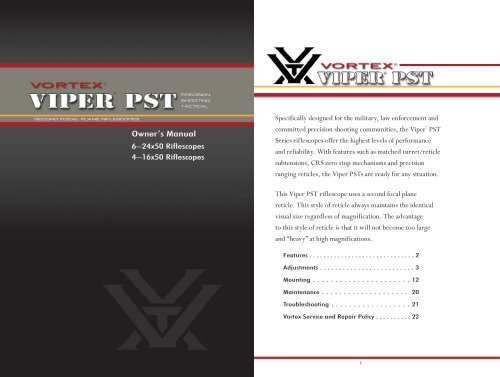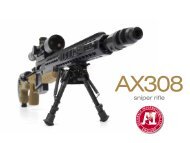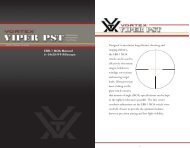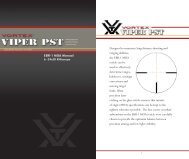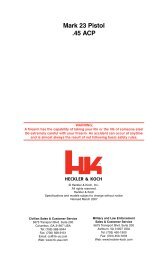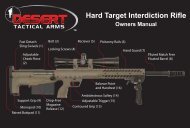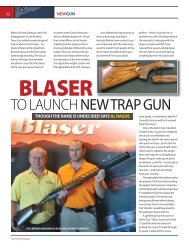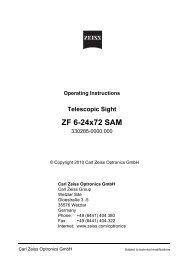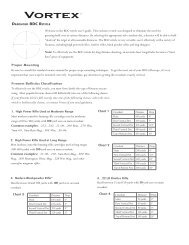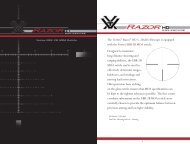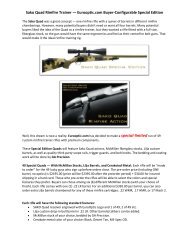vortex viper pst 6-24x50 moa rifle scope manual - EuroOptic.com
vortex viper pst 6-24x50 moa rifle scope manual - EuroOptic.com
vortex viper pst 6-24x50 moa rifle scope manual - EuroOptic.com
- No tags were found...
You also want an ePaper? Increase the reach of your titles
YUMPU automatically turns print PDFs into web optimized ePapers that Google loves.
PRECISIONSHOOTINGTACTICALSECOND FOCAL PLANE RIFLESCOPESOwner’s Manual6–<strong>24x50</strong> Rifle<strong>scope</strong>s4–16x50 Rifle<strong>scope</strong>sSpecifically designed for the military, law enforcement and®<strong>com</strong>mitted precision shooting <strong>com</strong>munities, the Viper PSTSeries <strong>rifle</strong><strong>scope</strong>s offer the highest levels of performanceand reliability. With features such as matched turret/reticlesubtensions, CRS zero stop mechanisms and precisionranging reticles, the Viper PSTs are ready for any situation.This Viper PST <strong>rifle</strong><strong>scope</strong> uses a second focal planereticle. This style of reticle always maintains the identicalvisual size regardless of magnification. The advantageto this style of reticle is that it will not be<strong>com</strong>e too largeand “heavy” at high magnifications.Features . . . . . . . . . . . . . . . . . . . . . . . . . . . . . . 2Adjustments . . . . . . . . . . . . . . . . . . . . . . . . . 3Mounting . . . . . . . . . . . . . . . . . . . . . . 12Maintenance . . . . . . . . . . . . . . . . . . . . 20Troubleshooting . . . . . . . . . . . . . . . . . . 21Vortex Service and Repair Policy . . . . . . . . . . 221
Rifle<strong>scope</strong> AdjustmentsThe Vortex Viper PST Rifle<strong>scope</strong>Fast FocusIllumination KnobEyepieceElevationMagViewAdjustment KnobSide ParallaxFocus KnobReticle FocusMagnificationAdjustment RingWindageAdjustment KnobReticle FocusVortex Viper PST <strong>rifle</strong><strong>scope</strong>s use a fast focus eyepiece designedto quickly and easilyadjust the focus on the<strong>rifle</strong><strong>scope</strong>’s reticle.To adjust the reticlefocus:1. Look through the<strong>rifle</strong><strong>scope</strong> at a blank whitewall or up at the sky.Adjust the reticle focus2. Turn the eyepiece focusknob in or out until the reticle image is as crisp as possible.Note: Try to make this particular adjustment quickly, as the eyewill try to <strong>com</strong>pensate for an out-of-focus reticle.Zero ReferenceLinesRadius BarTurret CapRetaining ScrewsObjectiveLensIncludes a4-Inch SunshadeOnce this adjustment is <strong>com</strong>plete, it will not be necessaryto re-focus every time you use the <strong>rifle</strong><strong>scope</strong>. However,because your eyesight may change over time, you shouldre-check this adjustment periodically.WarningLooking directly at the sun through a rifl e<strong>scope</strong>, or any opticalinstrument, can cause severe and permanent damage to your eyesight.Dual Use: Shooting Tactical / Hunting2 3
Windage and Elevation AdjustmentsVortex Viper PST <strong>rifle</strong><strong>scope</strong>s incorporate precision fingerElevationadjustable elevation and windageKnobdials with audible clicks.To make adjustments:1. Turn the adjustment knob in theappropriate direction: Up/Downor Left/Right as indicated by thearrows.2. Move the knobs in the directionyou wish the bullet’s point-ofimpactto change.WindageKnobMOA or MRADDepending on which version you have purchased, your ViperPST <strong>rifle</strong><strong>scope</strong> will feature adjustments scaled in MOAs ormrads. If you are unsure of which scale is used, reference thetop of the adjustment turret.If the adjustment is in MOAs, If the adjustment is in mrads,the turret will displaythe turret will display“1 Click = ¼ MOA”.“1 click = .1 mrad”.Both minute-of-angle (MOA) and milliradian (mrad) unit ofarc scales are effective when using subtension measurements forranging and bullet trajectory drop <strong>com</strong>pensation in reticles.MOA AdjustmentsMOA unit of arc measurements are based on degrees andminutes. There are 360 degrees in a circle, 60 minutes in adegree for a total of 21,600 minutes in a circle. A minute ofangle will subtend 1.05 inches at a distance of 100 yards. ViperPST second focal plane <strong>rifle</strong><strong>scope</strong>s (except PST 1–4x24) withMOA adjustments use 1/4-minute clicks which subtend .26inches at 100 yards, .52 inches at 200 yards, .78 inches at 300yards, etc.Example: With each click of the Viper PST moving the point-of-impact1/4 MOA, it will take four clicks of the knob to move a bullet’s point-ofimpact1.05 inches at a 100 yard sight-in distance.MRAD AdjustmentsMrad unit of arc measurements are based on the radian. Aradian is the angle subtended at the center of a circle by an arcthat is equal in length to the radius of the circle. There are6.283 radians in all circles and 1000 milliradian in a radianfor a total of 6283 milliradians (mrads) in a circle. An mradwill subtend 3.6 inches at a distance of 100 yards. Viper PSTsecond focal plane <strong>rifle</strong><strong>scope</strong>s (except PST 1–4x24) with mradadjustments use .1 mrad clicks which subtend .36 inches at100 yards, .72 inches at 200 yards (2 cm at 200 meters), 1.08inches at 300 yards (3 cm at 300 meters), etc.Example: With each click of the Viper PST moving the point-of-impact.1 mrad (.36 inches), four clicks will move the bullet’s point-of-impact1.44 inches at a 100 yard sight-in distance. At 100 meters, four clickswill move the point-of-impact four centimeters.4 5
Parallax AdjustmentThis model of the Viper PST <strong>rifle</strong><strong>scope</strong> uses a side focusparallax adjustment which, whenproperly set, eliminates parallaxerrors.Parallax is a phenomenon thatresults when the target imagedoes not quite fall on the sameoptical plane as the reticle withinthe <strong>scope</strong>. When the shooter’sAdjust the side parallax knobeye is not precisely centered inthe eyepiece, there can be apparent movement of the targetin relation to the reticle, which can cause a small shift in thepoint of aim. Parallax error is most problematic for precisionshooters using high magnification.To set the parallax:1. Be sure the reticle is correctly focused (see Reticle Focus).2. As accurately as possible, match the yardage number(distance you are shooting) on side focus parallax adjustmentknob to the indicator arrow on the <strong>scope</strong> body.3. Check the setting for accuracy by moving your head backand forth while looking through the <strong>scope</strong>. The setting iscorrect if there is no apparent movement between the reticleand target. If there is apparent movement, adjust the focusknob slightly until the movement is eliminated.4. When properly set, the target image should be sharp andcrisp.Customizable Rotational Stop (CRS)Vortex Viper PST <strong>rifle</strong><strong>scope</strong> elevation turrets incorporate theunique CRS rotation stop feature. After the <strong>rifle</strong> is sighted in,the design of the CRS allows a shooter to quickly and easilyreturn to an original zero point when using the elevation turretto dial-in temporary bullet drop corrections.The CRS feature is particularly useful when dialing largemulti-revolution elevation corrections. Without this feature,the shooter must pay very careful attention when dialing theselarge corrections. If the shooter loses track of the number ofrevolutions, the original zero point may be<strong>com</strong>e lost whenreturning the adjustment. Viper PST <strong>rifle</strong><strong>scope</strong>s equipped withthe CRS allow the elevation dial to be quickly spun back tooriginal zero without having to carefully count revolutions orclicks.Once the CRS shims are installed after sight-in, the elevationdial will stop turning shortly past the original zero point whenbeing returned (turning clockwise direction) from a temporaryelevation adjustment. The shooter can then turn the elevationknob a partial turn in a counter-clockwise direction until thezero reference and radius bar are correctly aligned—achievingthe original zero point.See CRS shim installation in theBore Sighting and Final RangeSight-in sections.CRS Shims6 7
Variable Power AdjustmentsTo change magnifications, turn the magnification ring to thedesired level. The patented Vortex MagView will provide alow light reference for magnification level.The ViperPST 4–16x50and 6–<strong>24x50</strong><strong>rifle</strong><strong>scope</strong>swith secondfocal planereticles use adual numbermarkingsystem on themagnificationdial. The 1x,SubtensionMultiplier MarkingsMagnificationMarkingsMagView2x, 3x, and 4x subtension multiplier markings on the backside of the magnification numbers can be used in conjunctionwith the reticle to help calculate distances and holdovers atvarying magnifications.Magnification and SubtensionThe MOA or mrad subtensions listed in the reticle<strong>manual</strong> are only valid at the highest magnification of the<strong>rifle</strong><strong>scope</strong>—marked 1x on the subtension multiplier scale.However, by understanding the relationship of magnificationand subtensions, the shooter can still easily calculateranging, holdovers and wind drift at partial magnifications(2x, 3x and 4x markings).• If magnification is set at half of the full magnification,subtension values will be two times the spec listed in the <strong>manual</strong>.• If magnification is set at a third of the full magnification,subtension values will be three times the spec listed in the<strong>manual</strong>.• If magnification is set at a quarter of the full magnification,subtension values will be four times the spec listed in the<strong>manual</strong>.Model4–16x50Reticlesubtensionsvalid at 16xSubtension Changes with MagnificationRifle<strong>scope</strong>Magnification16x8x5.3x4xReticleMultiplier1x2x3x4xActual Subtensionof 1 mrad Reticle Space1 mrad2 mrads3 mrads4 mradsActual Subtensionof 2 MOA Reticle Space2 MOA4 MOAs6 MOAs8 MOAs6–<strong>24x50</strong>Reticlesubtensionsvalid at 24x24x12x8x1x2x3x1 mrad2 mrads3 mrads2 MOA4 MOAs6 MOAs6x4x4 mrads8 MOAs8 9
Turret RotationVortex Viper PST <strong>rifle</strong><strong>scope</strong>s incorporate Vortex’s patentedRadius Bar to visually assist inkeeping track of turret rotations.The radius bar provides a quickvisual reference that allows theshooter to confirm:• Knob orientation is correctand has not shifted as a result ofaccidental contact.Radius Bar• Knob orientation is at the zero point when using the CRSfeature.• By watching the position of the bar while making elevationadjustments, the shooter is able to quickly track full, half andquarter rotations.To get these benefits from the Radius Bar, the “0” markon the turret must be indexed with the zero reference lineon turret post. See the section on Setting the CRS Stop andIndexing Elevation Knob.Illumination AdjustmentsThe Vortex Viper PST <strong>rifle</strong><strong>scope</strong>s use a variable intensityreticle illuminationsystem to aid in lowlight performance.To activate theillumination, rotatethe adjustment knobin either direction.The illuminationknob allows for 10levels of brightnessMagViewIlluminationKnobintensity; an off click between each level allows the shooterto turn the illumination off and return to a favored intensitylevel with just one click. The top five settings (6, 7, 8, 9 and10) are visible in the daytime, depending on the backgroundcolor. Settings below 6 are for low light use when the user’seyes have adjusted to lower light levels. Lowest settings arefor use with night vision devices.Replacing the Illumination BatteryBattery Cap1. Unscrew the outer cap with a coin.2. Remove the battery.3. Replace with a new CR2032 battery.10 11
Rifle<strong>scope</strong> MountingTo get the best performance from your Vortex Viper PST<strong>rifle</strong><strong>scope</strong>, propermounting is essential.Although not difficult,the correct steps mustbe followed. If you areunsure of your abilities,it would be best touse the services of aqualified gunsmith.Centering of the ReticleThe Vortex Viper PST <strong>rifle</strong><strong>scope</strong> is pre-set from the factorywith the reticle in the center of the adjustment ranges.If you have changed the settings and wish to approximatelyreset the reticle to the center, this can be done easily:1. Turn the windage or elevation dial as far as possible in eitherdirection. Do not force the dial. As soon as any any resistance is felt,stop turning.2. Carefully count the dial rotations while turning the dial backin the opposite direction. Stop turning as soon as resistance is felt.Rings and BasesMount an appropriate base and matching rings to your <strong>rifle</strong>according to the manufacturer’s instructions. The VortexViper PST <strong>rifle</strong><strong>scope</strong>s require 30mm rings.Vortex Optics highly re<strong>com</strong>mends using the Vortex OpticsPrecision Matched 30mm ring sets which may be purchasedfrom an authorized Vortex <strong>rifle</strong><strong>scope</strong> dealer. These ringswill mount to any Picatinny spec base.Note: If shooting at distances in excess of 800 yards with 4–16x50 or6–<strong>24x50</strong> models, Vortex Optics re<strong>com</strong>mends use of a 20 MOA cantedPicatinny rail or 30mm rings with adjustable offsets. These can bepurchased through <strong>com</strong>panies such as Badger Ordnance, Barrett Mfg.,EGW, Burris, and others.If using an aftermarket base and ring setup, use the lowestring height that will provide <strong>com</strong>plete clearance of <strong>scope</strong> and<strong>rifle</strong>—avoiding any contact with barrel, receiver, bolt handleor any other part of the <strong>rifle</strong>. A low mounting will helpassure proper cheek weld, aid in establishing a solid shootingposition, and promote fast target acquisition.3. Turn the dial the other direction to half the amount ofrotations counted in step one.Complete this procedure for both windage and elevationdials to approximately center the reticle.12 13
Eye Relief and Reticle AlignmentAfter installing the bottom ring halves on the mounting base,place the <strong>rifle</strong><strong>scope</strong> on the bottom ring halves and loosely installthe upper ring halves. Before tightening the <strong>scope</strong> ring screws,adjust for maximum eye relief to avoid injury from recoil:1. Set the <strong>rifle</strong><strong>scope</strong> to the middle of its magnification range.2. Slide the <strong>rifle</strong><strong>scope</strong> as far forward as possible in the rings.3. While viewing through the <strong>rifle</strong><strong>scope</strong> in a normalshooting position, slowly slide the <strong>rifle</strong><strong>scope</strong> back towardsthe shooter’s face—paying attention to the field of view. Justas the full view is visible, stop.4. Without disturbing the front-back placement, rotatethe <strong>rifle</strong><strong>scope</strong> until the vertical crosshair exactly matchesthe vertical axis of the <strong>rifle</strong>. Use of a reticle leveling tool, aweight hung on a rope, or an adjustable set of feeler gaugeswill help with this procedure.Bore SightingInitial bore sighting of the <strong>rifle</strong><strong>scope</strong> will save time andmoney at the range. This can be done by using a mechanicalor laser bore sighter according to the manufacturer’sinstructions or by removing the bolt and sighting throughthe barrel on some <strong>rifle</strong>s.To visually bore sight a <strong>rifle</strong>:1. Place the <strong>rifle</strong> solidly on a rest and remove the bolt.2. Sight through the bore at a target approximately 100 yardsaway.3. Move the <strong>rifle</strong> and rest until the target is visually centeredinside the barrel.4. With the target centered in the bore, make windage andelevation adjustments until the reticle crosshair is also centeredover the target.5. After aligning the reticle, tighten and torque the ringscrews down per the manufacturer’s instructions.Use of an adjustable set of feelergauges between a one-piecebase and fl at bottom sectionof the rifl e<strong>scope</strong> to square therifl e<strong>scope</strong> (and reticle) to thebase.Visually bore-sighting a rifl e.14 15
Final Range Sight-In and CRS Stop SetAfter the <strong>rifle</strong><strong>scope</strong> has been bore-sighted, final sight-in andCRS stop set should be done at the range using the exactammunition expected to be used while shooting. Sight in andzero the <strong>rifle</strong><strong>scope</strong> at the preferred distance. 100 yards is themost <strong>com</strong>mon zero distance, although a 200 yard zero may bepreferred for long range applications.Be sure the reticle is in focus (see Reticle Focus section) and setthe parallax adjustment to match the distance being used forsight-in:Setting the CRS Stop and Indexing Elevation KnobAfter obtaining a satisfactory zero, the CRS stop can be set ifdesired:1. Loosen the three turret cap retaining screws on theelevation turret. Gently pull the turret cap straight up and offof the turret post, being careful not to rotate the turret post.2. Slide the CRS shims on the center section of the turret postbelow the V-grooved part.Place CRS shimsin this groove.1. Following all safe shooting practices, fire a three-shot groupas precisely as possible.2. Next, adjust the reticle to match the approximate center ofthe shot group (see section on Windage and Elevation Adjustment).Note: If the rifl e is very solidly mounted and cannot be moved, simplylook through the <strong>scope</strong> and adjust the reticle until it is centered on thefi red group.3. Carefully fire another three-shot group and see if the bulletgroup is centered on the bullseye.Alternate shim installation direction180 degrees with each shim.This procedure can be repeated as many times as necessaryto achieve a perfect zero.Use as many shims as necessary to<strong>com</strong>pletely fi ll up the space. Donot try to force in a last shim oncethe clearance is very close—a tinyremaining gap is normal.16 17
1. After filling the center gap on the post with shims, replace theelevation cap.2. Align the turret cap so the “0” mark on the cap matches upwith the “0” reference line on the turret post. Again, be sure notto rotate the actual turret mechanism in the process.3. Re-tighten the retainingscrews, but do not overtighten.Use of thumb and forefinger onthe short end of the hex wrenchwill provide sufficient force.Align the elevation turret cap.Using the CRS Zero StopOnce the CRS shims are installed, the elevation dial willstop turning shortly past the original zero point when beingreturned (turning clockwise direction) from a temporaryelevation adjustment.Point at which theknob stops turning.Indexing the Windage Knob1. Loosen the three retaining screws on windage turret cap.2. Carefully rotate the cap until the “0” mark on the capmatches up with the “0” reference line on the turret post. Besure that the cap is freely turning and that you don’t rotate theactual turret mechanism.3. Re-tighten the windage knob retaining screws, but do notovertighten. Use of thumb and forefinger on the short endof the hex wrench will providesufficient force.Turn the elevation knob a partial turn in a counter-clockwisedirection until the Radius Bar is correctly aligned with <strong>scope</strong>axis and zero marks match. This setting will match theoriginal zero point.Correct alignment forzero point.Once the windage and elevationknobs are correctly indexed to thezero mark, temporary correctionscan be safely dialed into the<strong>scope</strong> without worry of losing theoriginal zero.Align the windage turret cap.If re-zeroing at a future time, be sure to remove all CRSshims before sight-in.18 19
MaintenanceCleaningThe fully waterproof and fogproof Vortex Viper PST<strong>rifle</strong><strong>scope</strong> requires very little routine maintenance otherthan periodically cleaning the exterior lenses. The exteriorof the <strong>scope</strong> may be cleaned by wiping with a soft, dry cloth.When cleaning the lenses, be sure to use products, such asthe Vortex Fog Free cleaning products or Lens Pen, that arespecifically designed for use on coated optical lenses.• Be sure to blow away any dust or grit on the lensesprior to wiping the surfaces.• Using your breath, or a very small amount of water orpure alcohol, can help remove stubborn things like driedwater spots.LubricationAll <strong>com</strong>ponents of the Vortex Viper PST <strong>rifle</strong><strong>scope</strong>s arepermanently lubricated, so no additional lubricant should beapplied.Note: Other than to remove the turret caps, do not attempt todisassemble any <strong>com</strong>ponents of the rifl e<strong>scope</strong>. Disassembling ofrifl e<strong>scope</strong> may void warranty.StorageIf possible, avoid exposing your Vortex <strong>rifle</strong><strong>scope</strong> to directsunlight or any very hot location for long periods of time.TroubleshootingSighting-in ProblemsMany times, problems thought to be with the <strong>scope</strong> are actuallymount problems. Be sure the mounts are tight to the <strong>rifle</strong> andthe <strong>scope</strong> is secured so it doesn’t twist or move in the rings.An insufficient windage or elevation adjustment range mayindicate problems with the base mount, base mount holes drilledin the <strong>rifle</strong>’s receiver, or barrel/receiver alignment.Check for Correct Base and Ring Alignment1. Re-center the <strong>scope</strong> reticle (see Centering of the Reticle).2. Attach bore sighter, or remove bolt and visually boresight <strong>rifle</strong>.3. Look through the <strong>scope</strong>. If the reticle appears way off centeron the boresighter image or when <strong>com</strong>pared to the visuallycentered target when looking through <strong>rifle</strong>’s bore, there maybe a problem with the bases or rings being used. Confirmthat correct base and rings are being used—and in the properorientation.Grouping ProblemsThere are many issues that can cause poor bullet grouping.• Maintain a good shooting technique and use a solid rest.• Check that all screws on <strong>rifle</strong>’s action are properly tightened.• Be sure <strong>rifle</strong> barrel and action are clean and free of excessiveoil or copper fouling.• Check that rings are correctly torqued per the manufacturer’sinstructions.• Some <strong>rifle</strong>s and ammunition don’t work well together—trydifferent ammunition and see if accuracy improves.20 21
Vortex Service and Repair PolicyUnconditional Lifetime WarrantyVortex Optics wants you to shootand use your Viper PST <strong>rifle</strong><strong>scope</strong>under any conditions with<strong>com</strong>plete confidence—that’s whyour warranty is straightforwardand simple:• Fully transferable• No warranty card needed• No receipt neededUnconditional LifetimeWarrantywww.<strong>vortex</strong>optics.<strong>com</strong>Rest assured, if this <strong>rifle</strong><strong>scope</strong> should ever require repair, allyou need to do is contact Vortex for absolutely free service.Call 800-426-0048 or e-mail service@<strong>vortex</strong>optics.<strong>com</strong>.Vortex Optics2120 West Greenview DriveMiddleton, Wisconsin 53562USAPatents Pending on MagView System, Radius BarDual Use: Shooting Tactical / HuntingManual #2-P22


